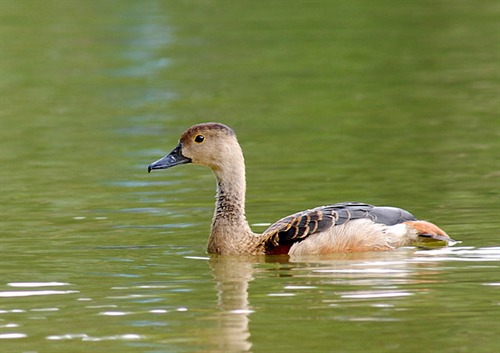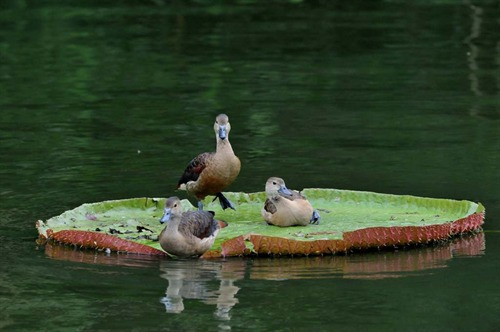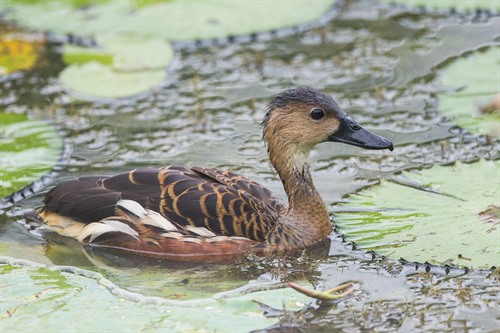
Back
Dendrocygna javanica (Horsfield, 1821)
| Family Name: | Anatidae |
| Taxonomic Group: | Vertebrates (Bird) |
| Common Name: | Lesser Whistling Duck |
Name
Description
| Description | The adult has dull plain plumage with a long neck, round wings with chestnut lesser and median upperwing-coverts; dark headcap with rufous fringes to mantle feather and scapulars and chestnut uppertail coverts; middle of nape and hindneck are slightly paler than sides of neck; flank has indistinct thin white streaks. The juvenile is duller than the adult; more greyish brown with a paler crown. |
|---|
Ecology, Habitat & Location
| Ecological Notes | A shy waterfowl preferring freshwater wetlands, especially shallow ponds and marshes, where it spends much of its time foraging for food in close-knit family flocks. Feeds mainly by dabbling the water surface for floating vegetable matter but also taking in insects and other aquatic invertebrates. Often dives. A rather nervous species liable to take flight at the first sign of danger. Can be active both in the day and night, depending on degree of disturbance. Nests in vegetation close to water but occasionally in trees. Each clutch can contain a maximum of ten eggs and young attain maturity in three months. |
|---|---|
| Habitats | Freshwater |
| Distribution | Found mainly around the coasts but concentrated along the north and west of Singapore. Also found on the island of Pulau Tekong. Semi-tame individuals seen at Marina South and Botanic Gardens may have been derived from captive stock. This species occurs from India to southern China and Southeast Asia. |
| Nature Areas | Pulau Tekong, Western Catchment Area, Lorong Halus |
Conservation
| Trends & Threats | Loss of habitat and associated disturbances have reduced the Singapore population to its current low level and rather fragmented range. A second threat is poaching, either through the use of shotguns or nets strung across ponds. |
|---|---|
| Scientific Interest & Potential Value | This is one of only two known resident species of wild ducks still present in Singapore, and it can still be seen by the general public for whom it is an attraction at various water bodies. |
| Conservation Notes | Estimated at 50-200 birds. Singapore Botanic Gardens is a National Park and has viable populations of this native duck. Preservation of these sites by itself is not enough to prevent this species from becoming extinct. Protection, which has been inadequate thus far, is also vital as is more effective enforcement of relevant acts such as the Wild Animals and Birds Act (1971). |
Status
| Species Status | Resident breeder |
|---|---|
| Conservation Status | Uncommon |
| Singapore Red Data Book Status | Endangered (EN) [2008] |
Photos
References
| References | Davison, G.W.H., Ng, P.K.L. & Ho, H.C (Eds.). 2008. The Singapore Red Data Book (2nd Edition). Singapore: Nature Society (Singapore). 285pp Robson, C. 2000. A Field Guide to the Birds of Southeast-Asia. United Kingdom: New Holland Publishers. 544pp Wang, L.K. & Hails, C.J. 2007. An annotated checklist of the birds of Singapore. Raffles Bulletin of Zoology Supplement no. 15. 179pp |
|---|


